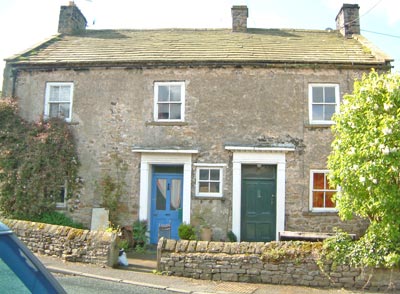


Grinton Workhouse
 There is evidence for a former staircase at the central front of the property which would have led to dormitories to the east and west in the roof space. I believe this staircase was accessed through a former doorway where the current small window now is. This doorway would also have given access to the west (right) side (White Lea Cottage) which could also have been former 'work' rooms, family rooms or Guardian rooms. There is a stone staircase accessing the first floor from the room at the back.
There is evidence for a former staircase at the central front of the property which would have led to dormitories to the east and west in the roof space. I believe this staircase was accessed through a former doorway where the current small window now is. This doorway would also have given access to the west (right) side (White Lea Cottage) which could also have been former 'work' rooms, family rooms or Guardian rooms. There is a stone staircase accessing the first floor from the room at the back.
There is a former doorway to the east (left) of the current White Lea entrance, which led on to a former staircase accessing the first floor, these rooms could also have served as work rooms, family rooms or Guardian rooms.
There are former doorways linking the two sides. Two on the ground floor two on the first floor and one on the second.
The central room to the rear of the property (now White Lea kitchen) has ceiling irons and stone shelving consistent with a larder. The door to this room (seemingly original) has a large wooden lock on it!
Now it is two private cottages, White Lea and Whitelea Cottage, named after a previous owner by the name of White.
|
The history of poorhouses / workhouses locally does not seem to be well recorded, but... |
|
|
1752 |
Earliest record which is in the Grinton parish register is of paupers dying in the poorhouse at Grinton |
|
|
Small poor houses existed in many towns and villages until the reforms of the 1830s |
|
1782 |
The Gilbert Unions - parishes joined together to provide poor relief and poorhouses |
|
1813 |
Grinton joined with the Bainbridge workhouse in Wensleydale (the dale to the south) but withdrew in 1827/8 |
|
1837 |
The Poor Law Union in Richmond joined 44 parishes together, presumably including Grinton. In December of that year the Guardians for Reeth, Arkengarthdale, Grinton, Marrick and Ellerton Abbey met in Reeth to save the paupers in those parishes having to travel to Richmond to state their cases. Links for more information on Richmond Workhouse are here and on the Richmond page of the Genuki web-site about 4/5ths of the way down. Please use your browser back button to return to this page. |
|
1840 |
The Reeth Union was formed and in July the Reeth work house was bought. Links for more information on Reeth Workhouse are: ‘Out of Oblivion#1’ and ‘Out of Oblivion#2’ and institutions.org.uk and 4. Please use your browser back button to return to this page. |
For lots more information on workhouses, go to Peter Higginbotham's site at www.workhouses.org.uk This site really is a treasure trove of information and photographs on the history of, and conditions within, workhouses and poorhouses around the country. Just enter Grinton, Reeth or Richmond in the search box for the local references.
This site quotes Grinton [near Reeth] as having 40 places whereas Grinton [near Leyburn] had 35 places.
Click for The Archaeology Data Service, Record ID - NMR_NATINV-560265, page about Grinton Workhouse.
Sources include the authoritive book 'A History of Richmond and Swaledale' by R. Fielding and B. Jennings and Michael the present occupant of the Eastern side.
| Information - All items |
| Councils |
| Businesses |
| Information links |
| Maps |
| Weather and river levels |
| Contacts |
| Richmond Council |
| Grinton Parish Council |
| Melbecks Parish Council |
| Reeth Parish Council |
| Google map |
| Bing map |
| Reeth Gazette |
| Reeth Gazette archive |
| What's on? - All entries |
| Diary dates |
| Reeth Memorial Hall Events |
| Tour_de_France |
| Places - All entries |
| Grinton |
| Reeth |
| Villages |
| Churches and Chapels |
| St. Andrew's Church, Grinton links |
| Tour of St. Andrew's Church |
| St. Andrew's Church Memorials |
| Grinton War Memorials |
| Grinton Church history |
| Gunnerside |
| My Photos |
| Old photos |
| Photo external links |
| Assorted photos |
| Walk along the riverpath from Grinton |
| Grinton Marrick Circular Walk |
| Grinton Views |
| Flooding near Grinton |
| Skies over Swaledale |
| Reeth in the snow |
| Tim Mason archive |
| The Millennium in Grinton |
| Jubilee 2002 including Corpse Way enactment |
| Local history |
| Mining history |
| Family history |
| Church Memorials |
| Churchyard Plans |
| Church Photos |
| War Memorials |
| Church history |
| Church links |
| Conservation Project |
| Parish Newsletter |
| Grinton |
| Blackburn Chapel |
| Chancel |
| East Window |
| Nave |
| North Aisle |
| South Aisle |
| Old Photos |
| Church Bells |
| Church Clock |
| Outside |
| In the Snow |
| Church Roof |